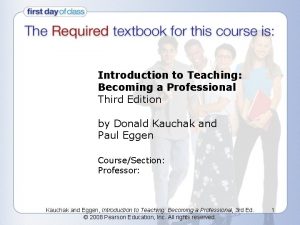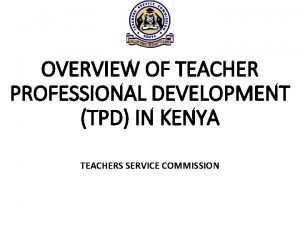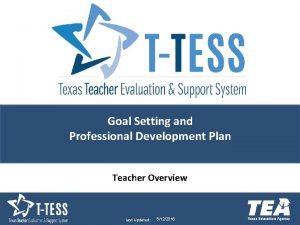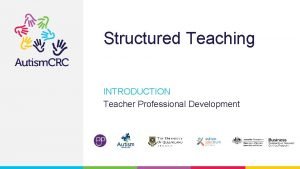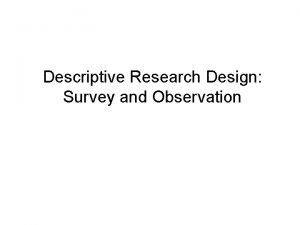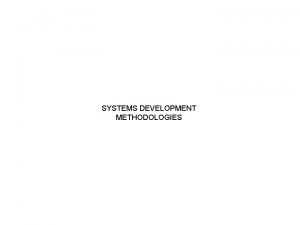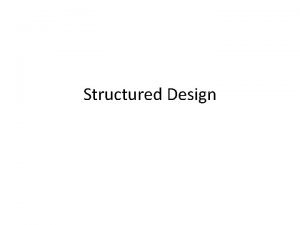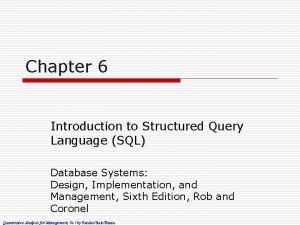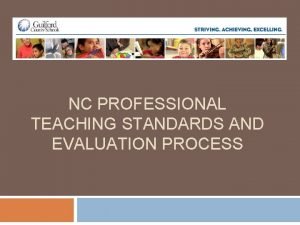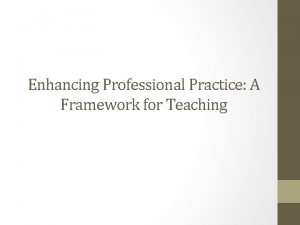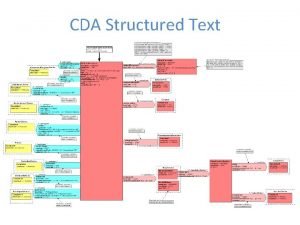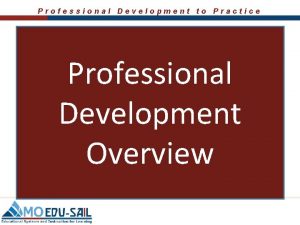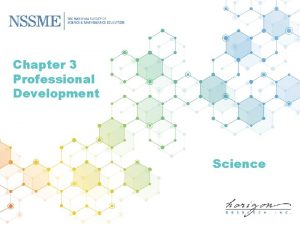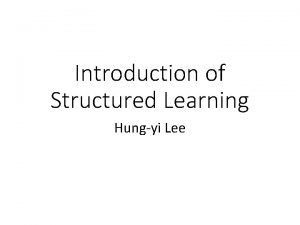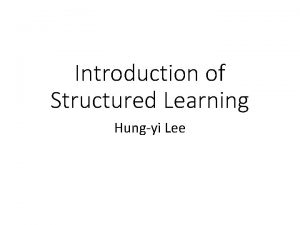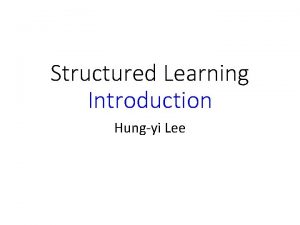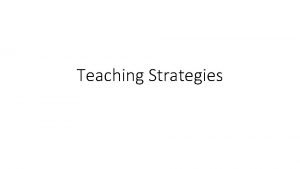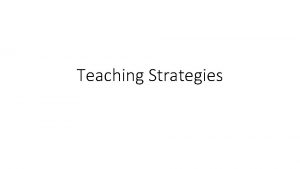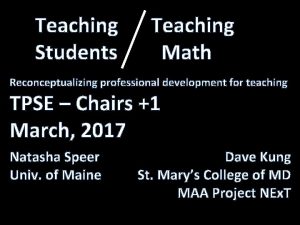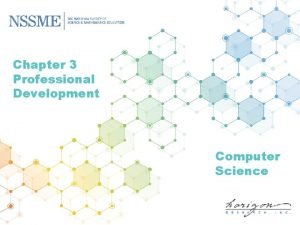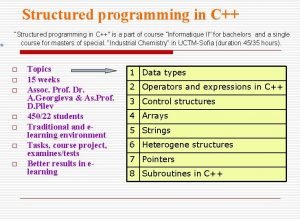Structured Teaching INTRODUCTION Teacher Professional Development Teacher Professional




















- Slides: 20

Structured Teaching INTRODUCTION Teacher Professional Development

Teacher Professional Development Overview of Structured Teaching An Introduction In this Teacher Professional Development, you will find practical information on the following: • What is Structured Teaching? • Focus of Structured Teaching • Elements of Structured Teaching 1. 2. 3. 4. Physical Structure Visual Schedules Work Systems Visual Structures • ‘Culture of Autism’ and Structured Teaching • How does Structured Teaching work? • Benefits of Structured Teaching • Some resources on Structured Teaching

Teacher Professional Development What is Structured Teaching? § A comprehensive intervention originally designed to support students on the autism spectrum § Designed in view of the characteristics of autism that affect learning 1 § Derived from the Treatment and Education of Autistic and related Communication Handicapped Children (TEACCH®) program at the University of North Carolina § Often used in special schools, autism-specific schools and has been used in a other contexts (e. g. workplace, home) § Used with individuals on the spectrum of all ages and functioning levels 2 1 Mesibov, 2 Mesibov Shea, & Schopler, 2004. & Shea, 2011.

Teacher Professional Development What is Structured Teaching? continued The Structured Teaching approach aims to modify the environment to enhance meaning for students and increase their academic and adaptive skills 1. Research indicates that these modifications should include: Ø Structured sessions for learning experiences Ø Instructions given primarily via visual information Ø Explicit organisation of materials 2 This Autism CRC project focused on the use of two of its elements (Visual Schedules and Work Systems) in mainstream classrooms 3. Mesibov, Shea, & Schopler, 2004. Schopler et al. , 1971; Schopler, Mesibov, & Hearsey, 1995; Mesibov, Shea, & Schopler, 2004; Hume & Odom, 2007. 3 Mac. Donald, Keen, Ashburner, Costley, Haas, & Trembath, 2017. 1 2

Teacher Professional Development What is Structured Teaching? continued Structured Teaching provides a systematic approach to learning and teaching through the: • Organisation of learning environment • Routine, structure and visual clarity Structured Teaching meets students’ needs by • Individualising materials and methods • Using individual interests or strengths ü Reduce STRESS ü Reduce FRUSTRATION ü Reduce ANXIETY For students on the spectrum For other students in the classroom For you, as a teacher!

Teacher Professional Development The Focus of Structured Teaching Create a structured & predictable environment Clearly defining tasks & expectations Catering to the ‘culture of autism’ Working with the STRENGTHS & INTERESTS of each student

Teacher Professional Development Elements of Structured Teaching There are 4 main elements* of Structured Teaching that provide a framework in supporting students. 1. Physical Structure 2. Visual Schedules 3. Work Systems 4. Visual Structures These elements support the creation of a structured and predictable environment combined with clearly defined tasks and expectations while catering to the culture of autism. * Research across the field of TEACCH varies and some authors or information may identify or state a 5 th element of Structured Teaching or slightly reword the titles of each element. The overall principles of Structured Teaching are incorporated in the above 4 elements.

Teacher Professional Development 1. Physical Structure Reduce the distractions hanging from the roof, on walls or around the room. Organisation of classroom • Minimise visual & auditory distractions 1. Physical Structure 2. Visual Schedules 3. Work Systems 4. Visual Structures Consider where you might place a student on the spectrum based on their needs Clearly marked areas using equipment, carpet & walkways to organise classroom

Teacher Professional Development 2. Visual Schedules Where And When Visual information depicting the • ‘where’ • ‘when’ • ‘what’ of an activity 1. Physical Structure 2. Visual Schedules 3. Work Systems 4. Visual Structures What

Teacher Professional Development What to do 3. Work Systems Visual information informing • ‘what to do’ • ‘how much’ When it is finished How much • ‘when it is finished’ • and ‘what next’ What next 1. Physical Structure 2. Visual Schedules 3. Work Systems 4. Visual Structures

Clear labelling with supporting images to match subject of activity 4. Visual Structures • Visual clarity colour coding, highlighting, labelling • Visual organisation • Visual instructions clear information on where to start and to finish and the sequencing of steps arrangement of materials and space 1. Physical Structure 2. Visual Schedules 3. Work Systems 4. Visual Structures Separated folder sections with Velcro tabs to organise materials Instructions on starting in To Do and moving work to Finished

Teacher Professional Development ‘Culture of Autism’ and Structured Teaching Visual Processing Attention to Details • The TEACCH approach, otherwise known as Structured Teaching, is based on using an approach that caters to the ‘culture of autism’. Sensory Communication Concepts of Time Intense interests & preferences Specific Routines & Settings • Mesibov and Shea (2009) refer to the ‘culture of autism’ as a range of characteristics and patterns of behaviours of people on the spectrum.

How does Structured Teaching work? GOAL of Structured Teaching is to maximise understanding of what is required Increase in Increased understanding enhances meaning making of task/activity Resulting in management of behaviours (self & directed) skills abilit y self-regulation Outcomes of increased independence & self-esteem Leading to more learning (& potential teaching opportunities) Decrease in stress & anxiety

Teacher Professional Development Benefits of Structured Teaching • Elements of Structured Teaching – Visual Schedules and Work Systems – have been the most experimentally researched • Visual Schedules: • Enhance on-task behaviour and facilitate independent transitions for students on the spectrum 1 • Work Systems: • Improve task accuracy and reduce teacher prompting for students on the spectrum in a general education classroom 2 • Increased engagement of students on the spectrum during lunch time play activities 3 Together, Visual Schedules and Work Systems help to increase on-task behaviour for students on the spectrum who are learning in mainstream classrooms 4 1 Knight, Sartini, and Spriggs, 2014. Hume, Plavnik, & Odom, 2012. 3 O’Hara & Hall, 2014. 4 Mac. Donald, 2017 2

Teacher Professional Development Some resources on Structured Teaching Website & Articles Go to the following link and download each of the four pdf articles on Structured Teaching https: //www. iidc. indiana. edu/pages/Structured-Teaching-Strategies-A-Series Book by Gary Mesibov, Victoria Shea and Eric Schopler (2006), Springer. Written by some of the co-founders of the TEACCH program and colleagues. This book describes the philosophy and practices of the TEACCH program since its inception almost 30 years ago to the current development of the internationally-renowned TEACCH centre in the United States, which offers interdisciplinary services and training. There may be slight variations in information but the principles are the same

Teacher Professional Development Some resources on Structured Teaching Video (4: 41) – Introduction to Structured Teaching Click on the image or go to the following link to view a video of a primary school student on the autism spectrum in her school environment. She demonstrates her school day and how Structured Teaching strategies are used to help her in the classroom. These strategies are individualised. You may choose to use more whole-of -class strategies for all students. https: //www. youtube. com/watch? v=vkym. Zzmg 4 jw Video (20: 39) – Components of Structured Teaching Educators demonstrate how they implement Structured Teaching in action in the mainstream classroom. Practical examples of how they have adapted the curriculum and learning activities into a structured form. These examples may be adapted further to suit the age and ability of students in your classroom. https: //vimeo. com/15113443 There may be slight variations in information but the principles are the same

Teacher Professional Development A Final Note This Teacher Professional Development on Structured Teaching: An Introduction was created and developed by Dr Satine Winter with the assistance of Stephanie Callaghan and overseen by Dr Jill Ashburner, Autism Queensland. The information contained within is adapted from the ‘Finished! The On-Task Toolkit – A teacher’s guide to using visual schedules and work systems in the mainstream classroom’ by Elizabeth Macdonald (Autism CRC funded Ph. D scholar, Griffith University) and Kaaren Haas (Autism Spectrum Australia, Aspect). Animated images were created by Studio G, Autism Queensland. Funding for this project was provided by Positive Partnerships and facilitated through project collaboration between the Autism CRC, Autism Queensland, Positive Partnerships, Autism Spectrum Australia (Aspect) and the University of Queensland. Thank you!

Teacher Professional Development References Hume, K. , Plavnick, J. , & Odom, S. L. (2012). Promoting task accuracy and independence in students with autism across educational setting through the use of individual work systems. Journal of Autism and Developmental Disorders, 42, 2084 -2099. doi: 10. 1007/s 10803 -012 -1457 -4 Hume, Kara. (2015). Structured Teaching Strategies: A Series. Resource Center for Autism. http: //www. iidc. indiana. edu/? page. Id=3520 Indiana Hume, K. & Odom, S. (2007). ‘Effects of an individual work system on the independent functioning of students with autism. ’ Journal of Autism and Developmental Disorders, 37, 1166– 80. Knight, V. , Sartini, E. , & Spriggs, A. D. (2014). Evaluating visual activity schedules as evidence-based practice for individuals with autism spectrum disorders. Journal of Autism and Developmental Disorders, 45, 157 -178. doi: 10. 1007/s 10803014 -2201 -z Mac. Donald, E. (2017). The use of structured teaching strategies to support students on the autism spectrum to stay on task in mainstream classrooms (Unpublished doctoral dissertation). Griffith University, Brisbane. Mac. Donald, L. , Keen, D. , Ashburner, J. , Costley, D. , Haas, K. , & Trembath, D. (2017). Piloting autism intervention research with teachers in mainstream classrooms. International Journal of Inclusive Education, 21, 1228 -1224. doi: 10. 1080/13603116. 2017. 1335355

Teacher Professional Development References Mesibov, G. B. , & Shea, V. (2011). Teacch. In J. S. Kreutzer, J. De. Luca, & B. Caplan (Eds. ), Encyclopedia of Clinical Neuropsychology (pp. 2472 -2477). New York, NY: Springer. Mesibov, G. B. , Shea, V. , & Schopler, E. (2004). The TEACCH approach to autism spectrum disorders. New York: Springer. O'Hara, M. , & Hall, L. J. (2014). Increasing engagement of students with autism at recess through structured work systems. Education and Training in Autism and Developmental Disabilities, 49, 568 -575. Schopler, E. , Mesibov, G. , & Hearsey, K. (1995). Structured teaching in the TEACCH system. In E. Schopler & G. Mesibov (Eds. ), Learning and Cognition in Autism (pp. 243 -268). New York: Plenum Press. Schopler, E. , Brehm, S. , Kinsbourne, M. & Reichler, R. (1971) ‘Effect of treatment structure on development in autistic children. ’ Archives of General Psychiatry, 24, 415– 421.

Thank you Autism CRC is the world’s first national, cooperative research centre focused on autism. We are taking a whole-of-life approach to autism focusing on early years, schools years and adulthood.
 Unstructured interview
Unstructured interview How can we integrate oop with sd/sa ?
How can we integrate oop with sd/sa ? Introduction to teaching becoming a professional
Introduction to teaching becoming a professional Classroom management plan example
Classroom management plan example Kenya professional teaching standards
Kenya professional teaching standards Teacher professional development plan template texas
Teacher professional development plan template texas What is structured teaching
What is structured teaching Teacher observation structured and unstructured
Teacher observation structured and unstructured Structured system development methodology
Structured system development methodology Structured application development
Structured application development Language
Language Introduction to structured query language (sql)
Introduction to structured query language (sql) Micro teaching is a scaled down teaching
Micro teaching is a scaled down teaching Nc professional teaching standards
Nc professional teaching standards Professional values in teaching scotland
Professional values in teaching scotland Enhancing professional practice: a framework for teaching
Enhancing professional practice: a framework for teaching Remedial teaching record
Remedial teaching record Code of ethics for professional teachers philippines pdf
Code of ethics for professional teachers philippines pdf How to end an email to a teacher
How to end an email to a teacher T tess goal examples
T tess goal examples Domain 6: community linkages and professional engagement
Domain 6: community linkages and professional engagement


